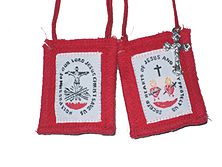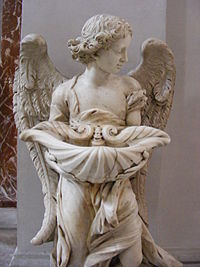- Sacramentals
-
 A Roman Catholic sacramental: Fivefold Scapular with Scapular of the Passion showing a tiny crucifix attached
A Roman Catholic sacramental: Fivefold Scapular with Scapular of the Passion showing a tiny crucifix attached
Sacramentals are material objects, things or actions (sacramentalia) set apart or blessed by the Roman Catholic Church, the Orthodox Churches, the Anglican Churches, and Old Catholic Churches to manifest the respect due to the Sacraments, and so to excite good thoughts and to increase devotion, and through these movements of the heart to remit venial sin, according to the Council of Trent (Session XXII, 15).
In Roman Catholicism Sacramentals such as Holy water, the Crucifix or the Saint Benedict Medal are recommended as a means of protection against evil.[1]
Contents
Roman Catholic, Orthodox and Anglican usage
When the term is used in the singular it is preceded by an article ("a sacramental" or "the sacramental") as sacramental is also an adjective describing the seven Sacraments.
These churches recognize two differences between the Sacraments and the sacramentals:
- The Sacraments were instituted by Jesus Christ; most, but not all, of the sacramentals were instituted by the Church.
- The Sacraments give grace of themselves and are always fruitful when the faithful place no spiritual obstacles in the way; the sacramentals excite pious dispositions, by means of which the faithful may obtain grace. It is not the sacramental itself that gives grace, but the devotion, love of God, or sorrow for sin that it inspires, and the prayers of the Church that render sacramentals efficacious against evil.
Although the Catholic Church restricts the reception of the Sacraments by non-Catholics, this is not true of the sacramentals. The pious use of sacramentals by non-Catholics is permitted and even encouraged. As blessed objects or rituals that represent sacred beliefs and persons, disrespect to sacramentals is considered a form of sacrilege.
The Catechism of the Catholic Church states that sacramentals "do not confer the grace of the Holy Spirit in the way that the sacraments do, but by the Church's prayer, they prepare us to receive grace and dispose us to cooperate with it." [2]
Protection against evil
Lay Catholics are not permitted to perform exorcisms but they can use Holy water and other sacramentals such as the Saint Benedict Medal or the Crucifix for warding off evil.[3]

The Saint Benedict Medal which includes the Vade Retro Satana formula to ward off Satan has been in use at least since the 18th century and in 1742 it received the approval of Pope Benedict XIV. It later became part of the Roman Catholic ritual.[4]
The Crucifix is widely considered to be one of the most effective means of averting or opposing demons, as stated by many exorcists, including the famous exorcist of the Vatican, Father Gabriele Amorth.[5]
The Catechism of the Catholic Church (number 301) specifically refers to the use of Holy water for "protection from the powers of darkness".[6] Catholic saints have written about the power of Holy water as a force that repels evil. Saint Teresa of Avila, a Doctor of the Church who reported visions of Jesus and Mary, was a strong believer in the power of Holy water and wrote that she used it with success to repel evil and temptations.[7]
The Scapular of St. Michael the Archangel is associated with Archangel Michael, the chief enemy of Satan. Pope Pius IX gave this scapular his blessing, but it was first formally approved under Pope Leo XIII. The scapular bears the well-known representation of the Archangel St. Michael slaying the dragon and the inscription "Quis ut Deus?" meaning Who is like God?.[8]
Marian sacramentals
A number of specifically Marian sacramentals are used only by some Roman Catholics. These include the Rosary, various scapulars, as well as medals such as the Miraculous Medal. The Rosary and the scapular are by far the most used Marian sacramentals.
Here are several Marian scapulars in use:
-
- The Scapular of Our Lady of Mount Carmel
- The Scapular of Our Lady of Ransom (B. Maria V. de Mercede redemptionis captivorum)
- The Black Scapular of the Seven Dolours of Mary
- The Blue Scapular of the Immaculate Conception
- The White Scapular of the Immaculate Heart of Mary
- The White Scapular of the Our Lady of Good Counsel
Of these, the Scapular of Our Lady of Mount Carmel has the largest following.
Examples
Some examples of rituals that are sacramentals are making the sign of the cross, bowing the head or bowing deeply, folding hands, genuflection, prostration, the imposition of blessed ashes (the ashes themselves are also a sacramental), the recital of blessings, the washing of feet, the celebration of the canonical hours and the seasons of the liturgical year, exorcisms, the reception of the minor orders, and the churching of women.
Statues and icons are examples of objects that are sacramentals. Other examples of objects that may be considered sacramentals are ashes, bells (especially church bells), blessed fire, blessed salt, candles, the nativity scene, the Advent wreath, crucifixes, holy oil, holy water, incense, liturgical vessels (e.g. chalices), a Mary garden, medals (e.g. the Miraculous Medal or the Saint Benedict Medal), palm branches, graves, funeral palls, religious habits and scapulars, rosaries, vestments, or wedding rings.
The use of Holy water as a sacramental for protection against evil is almost exclusive to Roman Catholics.[9] A number of other sacramentals such as the Little Sachet (associated with the Holy Name of Jesus) are used by Roman Catholics.[10]
Other examples may be found at Anglican devotions and Catholic devotions.
See also
- Rosary and scapular
- Holy water
- Saint Benedict Medal
References
- ^ Thoms O'Brian, An Advanced Catechism Of Catholic Faith And Practice, Kessinger Publishers, 2005, ISBN 1417984473, page 151
- ^ Catechism of the Catholic Church; no. 1670. Promulgated by Pope John Paul II in 1994.
- ^ Rosemarie Scott, 2006 'Clean of Heart' ISBN 0977223450 page 63
- ^ Lea, Henry Charles (1896) A History of Auricular Confession and Indulgences in the Latin Church Philadelphia: Lea Brothers & Co.
- ^ Boston Catholic Journal [1]
- ^ Thoms O'Brian, An Advanced Catechism Of Catholic Faith And Practice, Kessinger Publishers, 2005, ISBN 1417984473, page 151
- ^ Tessa Bielecki, Mirabai Starr, 2008 Teresa of Avila: The Book of My Life ISBN 1590305736 pp 238-241
- ^ Ann Ball, 2003, Encyclopedia of Catholic Devotions and Practices OSV Press ISBN 087973910X page 520
- ^ Henry Theiler, 2003 Holy Water and Its Significance for Catholics ISBN 0766175537 pp 13-15
- ^ Ann Ball, 2003 Encyclopedia of Catholic Devotions and Practices ISBN 0-87973-910-X page 319
External links
- Catechism of the Catholic Church: Sacramentals. Promulgated by Pope John Paul II in 1994.
- Baltimore Catechism No. 2, Lesson 27
- Catholic Encyclopedia: Sacramentals
Categories:- Sacramentals
- Christian terms
Wikimedia Foundation. 2010.


